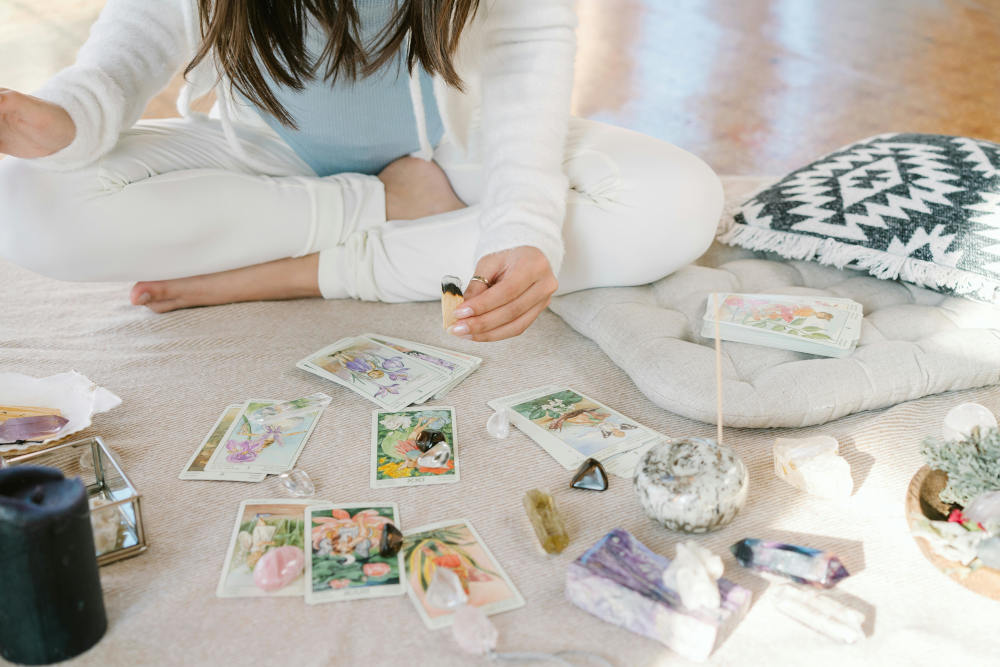
Getting a tarot reading for the first time can feel mysterious, exciting, or even a bit intimidating. Whether you're looking for insight into your future, clarity on a situation, or just curious about the process, understanding what actually happens during a tarot reading can help ease your mind and make the experience more meaningful.
In this article, we’ll walk you through what to expect before, during, and after a tarot reading. You’ll learn how tarot readings work, what kinds of questions you can ask, how to prepare, and what the cards can—and can’t—tell you.
Panaprium is independent and reader supported. If you buy something through our link, we may earn a commission. If you can, please support us on a monthly basis. It takes less than a minute to set up, and you will be making a big impact every single month. Thank you!
What Is a Tarot Reading?
A tarot reading is a form of divination that uses a deck of 78 cards to gain insight into a person’s life. Readers interpret the symbolism, imagery, and position of each card to provide guidance, reflection, or spiritual messages.
It’s important to note that tarot is not about predicting your fate with 100% certainty. Instead, it’s a tool for:
-
Self-reflection
-
Understanding current energies
-
Exploring potential outcomes
-
Clarifying decisions
A tarot reading is like holding up a mirror to your inner world. It helps you see what’s influencing your thoughts, emotions, and choices.
Before the Reading: What to Expect
1. Choosing a Reader
Tarot readers come in all styles—some are spiritual or intuitive, others are practical and down-to-earth. Some read professionally in metaphysical shops or online, while others offer casual readings at markets or events.
Before booking, consider:
-
Their reading style: Do they focus on predictions, healing, psychology, or empowerment?
-
Reviews or testimonials
-
Ethical approach: A good reader will never claim to “remove curses” or force you to buy more services.
2. Setting the Intention
Some readers will ask you to focus on a question or topic before the reading begins. You don’t always need a specific question—general guidance is also okay—but having an intention helps shape the reading.
Good questions might include:
-
“What should I know about my current relationship?”
-
“What energy surrounds my career path?”
-
“What do I need to focus on for personal growth?”
Avoid yes/no questions, and instead focus on open-ended, reflective prompts.
3. In-Person vs. Online Readings
-
In-person readings may include candles, crystals, or incense to create a sacred space.
-
Online readings (via Zoom, video, email, or chat) are just as effective, as energy is not limited by physical space.
During the Reading: Step-by-Step
1. Deck Selection
Some readers use one tarot deck exclusively, while others may offer you a choice. They might also include oracle cards or other divination tools depending on their practice.
2. Cleansing or Shuffling
To begin, the reader will shuffle the cards—sometimes while asking you to focus your energy or question. You may be asked to shuffle or cut the deck yourself (in person) to transfer your energy to the cards.
Some readers cleanse the deck between readings using sage, crystals, or intention to clear residual energy.
3. Choosing a Spread
A spread is the layout of cards that determines how the reading is structured. Common spreads include:
-
One-Card Pull: Quick insight or daily guidance
-
Three-Card Spread: Past / Present / Future or Situation / Obstacle / Advice
-
Celtic Cross: A more detailed 10-card spread showing influences, hopes, fears, and likely outcomes
-
Relationship Spread: Insights into romantic or interpersonal dynamics
-
Career Spread: Focused on work, goals, and decisions
The reader chooses a spread based on your question or intention.
4. Interpreting the Cards
The reader will turn over the cards one by one and interpret their meanings based on:
-
Card imagery and symbolism
-
Card position in the spread
-
Relationship between cards
-
Upright vs. reversed position (some readers use reversed cards to show blockages or opposite meanings)
For example, The Lovers in a relationship spread might suggest connection or choice, while The Tower could indicate sudden change or upheaval. But the exact interpretation depends on context.
5. Conversation and Insight
The best tarot readings are collaborative. A good reader may ask you questions, check in about what resonates, or offer interpretations that invite your input.
Some readers are very intuitive and focus on messages they receive through energy, while others stick more closely to traditional card meanings.
Remember, you’re not just a passive observer—your thoughts, emotions, and reactions are part of the reading process.
What You’ll Get Out of It
A tarot reading can offer many types of insight, depending on what you’re looking for:
1. Clarity
If you’re confused or stuck, the cards can reflect what’s going on and offer a fresh perspective.
2. Validation
Sometimes the cards affirm what you already know deep down but haven’t acknowledged.
3. Options and Outcomes
Tarot doesn’t tell you what will definitely happen—it shows possible paths based on your current energy or decisions.
4. Emotional Support
Many people find comfort in a reading, especially during times of grief, uncertainty, or major life transitions.
What Tarot Can’t Do
While tarot is a powerful tool, it’s important to have realistic expectations:
-
It can’t predict the future with 100% certainty. Free will, personal growth, and life circumstances are always in motion.
-
It can’t replace professional advice from doctors, therapists, or legal experts.
-
It won’t “fix” your problems for you—it will point the way, but you still have to walk the path.
Avoid readers who claim to do spellwork, remove curses, or offer overly dramatic warnings—these are often red flags for scams.
After the Reading: Integration and Reflection
1. Take Notes or Record
If possible, write down what cards came up and what the reader said. Many insights come later when you’ve had time to reflect.
2. Process Emotionally
Sometimes a reading stirs up deep emotions. Give yourself space to sit with what came up, journal about it, or discuss it with someone you trust.
3. Watch for Synchronicities
Many people notice signs, dreams, or repeating themes after a reading. This can be the universe’s way of affirming the message.
4. Take Action
Use what you learned to make empowered decisions. Tarot works best when paired with real-world action.
Common Misconceptions About Tarot Readings
1. “The cards will tell me my future.”
Tarot shows potential outcomes based on current energy. You always have the power to shift your path.
2. “If I get a ‘bad’ card, something bad will happen.”
Cards like Death, The Tower, or Ten of Swords are often misunderstood. They usually represent necessary transformation, release, or a turning point—not doom.
3. “Tarot is evil or against my religion.”
Tarot is not inherently tied to any religion. It’s a spiritual tool, not a supernatural force. Many people use it for reflection, mindfulness, and personal growth.
4. “You have to be psychic to read tarot.”
Not true! Anyone can learn tarot. While intuition helps, tarot reading is a skill you can develop with study and practice.
How Often Should You Get a Tarot Reading?
There’s no set rule. Some people get readings:
-
Weekly for guidance
-
Monthly for goal setting
-
Seasonally for big-picture planning
-
Only during transitions like breakups, job changes, or spiritual awakenings
Listen to your own inner guidance. Too many readings can become confusing if you're relying on them too heavily for every decision.
Final Thoughts
Getting a tarot reading can be a powerful and affirming experience. Whether it’s your first time or your fiftieth, each reading offers a chance to slow down, look inward, and listen to your intuition.
The process isn’t about magical answers—it’s about meaningful reflection. The cards don’t make decisions for you; they help you uncover the wisdom that’s already within.
So if you’re curious about getting a tarot reading, go into it with an open mind and heart. You might be surprised at what the cards have to say.
Was this article helpful to you? Please tell us what you liked or didn't like in the comments below.
About the Author: Alex Assoune
What We're Up Against
Multinational corporations overproducing cheap products in the poorest countries.
Huge factories with sweatshop-like conditions underpaying workers.
Media conglomerates promoting unethical, unsustainable products.
Bad actors encouraging overconsumption through oblivious behavior.
- - - -
Thankfully, we've got our supporters, including you.
Panaprium is funded by readers like you who want to join us in our mission to make the world entirely sustainable.
If you can, please support us on a monthly basis. It takes less than a minute to set up, and you will be making a big impact every single month. Thank you.































0 comments